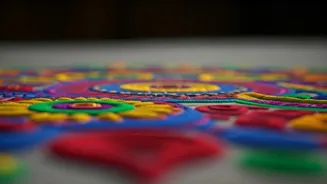Geometric Beginnings
Geometric rangoli designs are ideal for beginners due to their simplicity and structured nature. These patterns typically use basic shapes like circles,
squares, triangles, and lines to create symmetrical and visually appealing designs. Start by drawing a central shape, then build outwards with repeating patterns. You can use stencils to achieve precision, ensuring clean lines and consistent shapes. Another trick is to draw the outlines of your design with chalk before filling them with colours. Popular geometric designs include squares within squares, concentric circles, and star-like patterns. The beauty of geometric rangoli lies in its ability to look elegant and sophisticated with minimal effort, making it a perfect choice for any occasion. The core is using simple shapes such as squares and circles, then filling them with colours to create visual interest.
Floral Delights
Floral rangoli designs are a classic choice, evoking beauty and festivity with their natural charm. These designs incorporate flowers, leaves, and vines to create intricate and eye-catching patterns. You can use a variety of flowers, such as lotuses, roses, marigolds, and hibiscus, or simply represent these flowers using coloured powders. Start by sketching the outline of a flower or a bouquet, then fill it in with bright colours. One approach is to use petals to create a circular design or combine different flowers to make a more complex pattern. Consider layering colours to add depth and dimension to your designs. This adds a touch of elegance to your rangoli. Floral rangoli designs are particularly well-suited for occasions like Diwali and weddings, adding a sense of celebration and auspiciousness to the environment.
Material Matters
The materials used to create rangoli play a key role in the final look and feel of the design. Traditionally, rangoli is made using coloured powders. These powders, available in various vibrant shades, are the most common choice due to their ease of use and affordability. Other materials include rice flour, which can be used to create a more textured look, and flower petals, which add a natural and fragrant element. Stencils are helpful to create designs. For more complex patterns, you can opt for pre-made rangoli stencils, which offer precise outlines and reduce the time needed for drawing. Finally, you can also use colored sand to make an appealing rangoli. The choice of material influences the texture, appearance, and longevity of the rangoli, so select materials that suit your skill level and the specific occasion.
Occasion Specifics
Different festivals and occasions call for different rangoli designs, each reflecting the significance and spirit of the event. For Diwali, common designs include diyas (lamps), the goddess Lakshmi's footprints, and intricate patterns of light. During Holi, bright colours and playful themes are popular, showcasing the vibrancy of the festival. For Navratri, designs often feature the nine colours associated with the nine days of the festival. Wedding rangoli often have auspicious symbols, such as the Swastik, or represent couples. For occasions like Makar Sankranti, rangoli designs might show kites and other symbols of the harvest festival. By choosing designs that align with the specific occasion, you enhance the atmosphere and embrace the true spirit of the celebration.
Essential Techniques
Mastering a few simple techniques can greatly improve your rangoli creation process, regardless of the design. Practice controlling the flow of colour powder to achieve smooth lines and precise patterns. You can use your fingers, a small funnel, or even a bottle with a spout to pour the colours, depending on the design's complexity. Start with the outline of your design and then fill in the colours. Correct any mistakes by using a small brush or cotton swab to remove excess colour. Another important tip is to practice making the rangoli on a clean surface, such as a flat area. Keeping the area clear of debris will help you achieve a smooth and even finish. Proper preparation and technique are essential for creating a beautiful rangoli that will impress everyone.
Creative Tips
For added visual appeal, incorporate creative elements and tips. Consider using a combination of materials and techniques to enhance your designs. Layering colors can add depth and dimension. Try experimenting with different colour palettes to match the occasion or your personal preferences. Add small decorative items like diyas, mirrors, or beads to make your rangoli designs stand out. Using stencils to create precise patterns or outline the designs can be helpful. Another great idea is to create a theme, such as using only floral patterns or focusing on a specific colour scheme, to make your rangoli more unique. These creative additions can turn a simple rangoli into a stunning piece of art.




